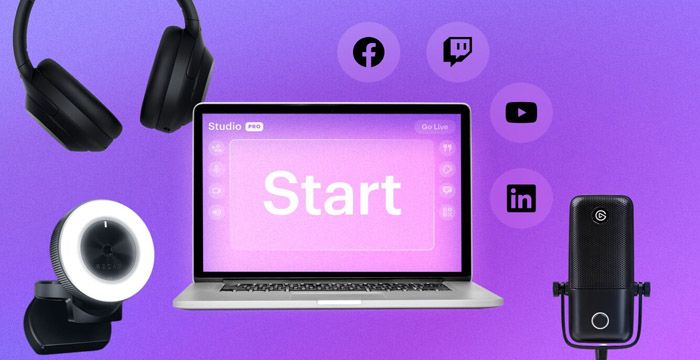Introduction
Game streaming has completely changed the way we play and watch video games. It is about broadcasting gameplay in real-time so others can watch, interact, and even learn from the streamer’s experience. It’s like tuning into a live sports event but for video games.
There are two major types of game streaming:
- Live Streaming – Gamers play in real-time while audiences watch on platforms like Twitch, YouTube Gaming, or Facebook Gaming. Streamers engage with their viewers through chat, reactions, and commentary, making it an interactive experience. Some even turn it into a full-time career, earning through sponsorships, ads, and viewer donations.
- Cloud Gaming – Instead of downloading or installing games, players stream games directly from cloud servers like Xbox Cloud Gaming, NVIDIA GeForce Now, or PlayStation Now. This eliminates the need for high-end gaming PCs or consoles, allowing players to enjoy high-quality graphics on almost any device with a strong internet connection.
With the rise of faster internet speeds and better streaming technology, game streaming is shaping the future of gaming. Whether you're a casual viewer, a competitive gamer, or someone who just wants to enjoy AAA titles without expensive hardware.
1. Choose the Right Streaming Platform
Before you start streaming, pick the platform that aligns with your goals. Here’s a quick breakdown:
- Twitch: The largest and most popular streaming platform, best for building an engaged audience.
- YouTube Gaming: Ideal to mix live streaming with pre-recorded content.
- Facebook Gaming: Great for tapping into an existing Facebook audience.
- Kick & Trovo: Emerging platforms with promising monetization opportunities.
Pro Tip:
Start with one platform to establish your brand before expanding to multiple platforms.
2. Get the Right Streaming Setup
While a high-end gaming PC isn’t required, you’ll need the right hardware and software for a smooth streaming experience.
Essential Hardware:
- PC or Console: It is recommended that you get a gaming PC with at least an Intel i5/Ryzen 5 processor and 16GB RAM. For consoles, Xbox and PlayStation support streaming with built-in apps.
- Capture Card: Necessary for streaming from consoles like Nintendo Switch.
- Microphone & Webcam: A quality mic like the Blue Yeti and a 1080p webcam enhance audience engagement.
- Dual Monitors: One for gameplay, another for monitoring chat and streaming software.
Best Streaming Software:
- OBS Studio: Free and highly customizable.
- Streamlabs OBS: User-friendly with built-in overlays.
- XSplit: Premium software with advanced features.
3. Optimize Your Stream Quality
Your stream quality impacts the viewer experience. Optimize these settings for a smooth broadcast:
Resolution: 1080p at 60fps is ideal, but 720p at 60fps works for slower connections.
Bitrate: Adjust based on internet speed (4500-6000 kbps for 1080p, 3000-4500 kbps for 720p).
Internet Speed: A stable upload speed of at least 5 Mbps is recommended.
Lighting & Background: Ensure good lighting and a clutter-free background for a professional look.
4. Engage with Your Audience
Viewers stay for the gameplay but return for the personality. Engage with your audience through:
- Chat Interaction: Read and respond to comments.
- Alerts & Overlays: Use tools like Streamlabs for alerts when someone follows or donates.
- Community Building: Join Discord and social media to stay connected with your followers.

5. Create an Eye-Catching Stream Layout
A visually appealing stream layout enhances viewer engagement. Essential elements include:
- Overlay: Customize your screen with branding elements.
- Chat Box: Display live chat on-screen for interactive sessions.
- Alerts: Highlight new followers, subscribers, and donations.
- BRB & Starting Soon Screens: Professional transitions for breaks and startup.
6. Develop a Consistent Streaming Schedule
Consistency builds a loyal audience. Follow these tips:
- Pick a Schedule: Stream at the same time weekly to develop a routine.
- Quality over Quantity: A few high-quality streams are better than daily low-quality ones.
- Promote Your Schedule: Use Twitter, Discord, and Instagram to inform followers.
7. Monetize Your Stream
Once you've built an audience, monetize your streams through:
- Subscriptions & Donations: Platforms like Twitch allow subscriptions and direct donations.
- Sponsorships: Partner with brands for promotions.
- Affiliate Links: Earn commissions through game and gear referrals.
- YouTube Ads: Monetize streams and videos via the YouTube Partner Program.
8. Improve Your Stream Over Time
Success in streaming is about constant improvement. Analyze and refine your content by:
- Tracking Metrics: Use Twitch/YouTube analytics to track engagement.
- Experimenting with Content: Try new game genres, themes, or interactive elements.
- Learning from Others: Watch top streamers to gain insights and strategies.
Final Verdict
Starting as a game streamer may seem challenging, but with the right approach, consistency, and engagement, you can grow your channel successfully. Remember, your personality, interaction, and content quality make all the difference. Ready to go live? Start today and refine your skills as you progress!
Post Comment
Be the first to post comment!
Related Articles




